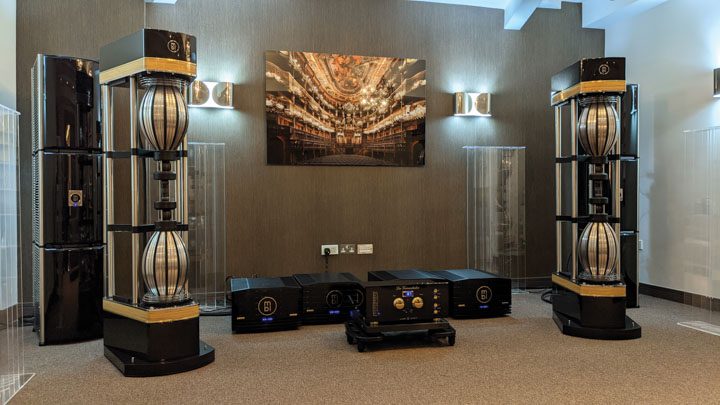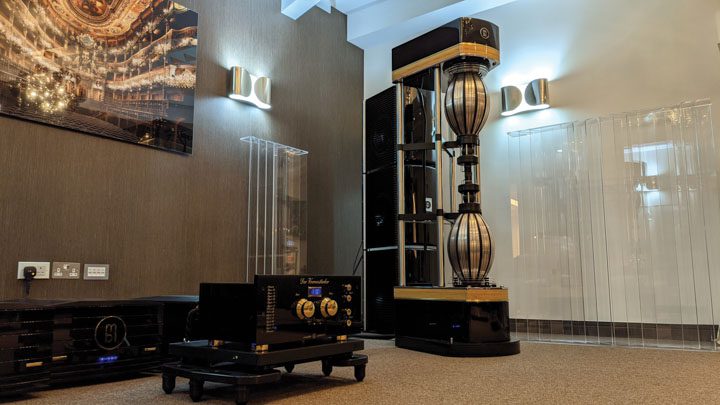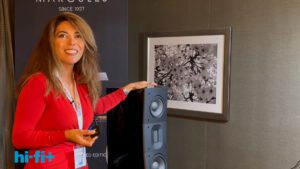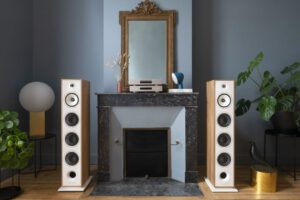
In part, this discussion of the MBL 101 X-Treme loudspeaker system is as much a discussion about the importance of a good dealer as it is related to the loudspeaker itself. You see, the 101 X-Treme isn’t the sort of loudspeaker you can ‘use’ out of the box; it requires precise and careful equipment partnering and installation and (generally) the kind of demonstrations that are more about working the client around the product than the other way around. In other words, this is as much about KJ West One in Central London as it is about MBL.
Listening to a pair of well-matched Radialstrahler MBL 101 X-Treme (to give it its full name) is perhaps understandably a rare event in the UK. The logistics involved and the size of typical listening rooms precludes too many dealers from being able to demonstrate the loudspeakers adequately, and the ‘set-up and settle down’ time needed to make these loudspeakers sing precludes rocking up to a show unless you can book the listening room two or three days in advance. This last one is almost impossible because many UK-based hotel/conference centres are fully booked during the week, meaning the Friday ‘get in’ for a Saturday show is commonplace. By MBL standards, that means the 101 X-Treme will be fine-tuned, bedded in and ready to sing at its best by about Thursday… four days after the show has ended.
The Long Game
KJ West One took the bold move of installing the MBL 101 X-Treme for the long game. The store handed over its main listening room to the MBL 101 X-Treme installation for some months in early 2022, allowing its clientele – and prospective MBL clients in the country – to visit the speakers in a fixed setting to hear them at their best.
Well, almost. KJ West One took the lockdowns to refurbish its listening room, testing several different room acoustics systems… and unfortunately, none are entirely up to the task. Ultimately, the room is both limited in speaker-to-listener distance and has a relatively low ceiling for large full-range designs. So, the room itself is working at about 90-95% of the potential, even if the loudspeakers were fully bedded in place and installed perfectly for the room.
This is not an ideal setting for a review. We should ideally have weeks to really get under the skin of a product, especially one at this price level, but recently such things have become increasingly difficult. Supply-chain concerns, the difficulties and costs involved in international shipping, and the relative scarcity of UK reviewers with listening rooms that could both take on the project in terms of time, load management and logistics make this more of a ‘visit’ than a ‘review. It’s also not exactly the newest device we have reviewed, and one that’s far outside our usual remit. But listening to the MBL 101 X-Treme isn’t something you turn down when you get the chance.
The MBL 101 X-Treme lives up to the ‘extreme’ name. It’s a sizeable four-tower loudspeaker that weighs in at close to one ton all up. It’s available as a full system too, which means a floor full of amplification. MBL wants to show its flagship off in the best possible light, which means a floor-full of MBL’s monoblocks, the matching preamplifier and even the digital front end from the company’s Reference Line.
The Big City Rule!
All up, whether or not you go down the full MBL amplifier route (and I suspect most prospective owners will end up with the full MBL package, or at least the amp/speaker combination, this is an audio system that is going to cost somewhere north of half a million… be they Pounds, Euros, or Dollars. Spending that kind of money on audio equipment is mainly self-filtering about room size; although the Big City Rule still applies (no matter the cost of the system, the cost of the real estate that sits beneath it is greater), so I can’t imagine too many 101 X-Treme systems end up in an apartment in the Mid-levels in Hong Kong… except maybe that 3,400 sq ft one that sold for $59m a couple of years ago.

What makes the 101 X-Treme so ‘extreme’? A big part is the omnidirectional speaker drivers in the main units, those distinctive onion-shaped transducers that look like something from a sci-fi movie. These units are hand-built in MBL’s factory, each one taking two weeks to build in a combination of coach-building and hand-crafted technology reminiscent of another era. This isn’t mass-production techniques building quasi-disposable equipment; it’s like hand-crafted measurement instruments from the Victorian era, except made to meet 21st Century standards and demands… along with slightly less brass and fewer galvanometers.
Normally, this kind of engineering would be overkill. Still, the Radialstrahler driver itself lends itself to this kind of precision engineering, and the pinnacle of that engineering takes time to construct. The Radialstrahler is a vertical circular laminate driver. The driver membranes (or lamellas) look like the outer faces of segments of an orange, each ‘orange’ equating to a specific frequency range, like a tweeter, midrange or bass woofer. The shape is more ‘oblate spheroid’ than round. All the segments stack vertically and are fixed at the top to a central rod arrangement, with the motive force of the drivers coming from a moving coil driving a thrust bearing at the base of the driver. The moving coil and magnet form a single unit with the coil moving in the air gap of the magnet. Where a conventional cone acts as a piston, the Radialstrahler pulsates outward organically because the vertical movement of the driver bends the lamellas in all directions. The result is sound that is radiated in an almost complete 360° sphere; an ideal point source in fact.
This idea underpins all of MBL’s omnidirectional designs, but when it comes to the 101 X-Treme, there are a lot of omnidirectional drivers in the same plane. The mirroring of the tweeter, midrange, and bass in the main units requires a heroic amount of rigidity of chassis, which goes some way to explaining the 265kg weight of the main unit; there are four thick steel rods to stop the top driver array from crashing into its mirror below.
The second tower on each side is almost a conventional active subwoofer… if ‘conventional’ to you is a sextet of proprietary side-firing 12-inch bass drivers with their balanced amplifier in a lacquered wood tower that stands over 6’1”. To make this system more manageable it breaks down into separate parts, but stacking a trio of the speaker unit, amplifier/second speaker unit, and third speaker unit is still something of a Herculean task for an installer.
Why Omni-directional?
MBL demonstrates ‘how’ it can be done, and there are few ‘proofs of concept’ more impressive than the 101 X-Treme. Still, perhaps a higher-order question is ‘why?’ The conventional radiating loudspeaker – whether a horn design, a cone-and-dome box or a dipole panel – radiates sound directly from driver to ear. Even though every conventional loudspeaker radiates sound off-axis and dipole/bipole designs radiate sound to the back and front of the loudspeaker, this direct approach is very much at odds with how instruments in the real world propagate sound. Suppose you think of an instrument like a grand piano. In that case, while the sound is directed toward the audience by the direction of the piano lid, there is also a lot of piano sound radiating out in all directions. In a live concert, close to three-quarters of the sound we hear is indirect, reflecting off the walls, floor and ceiling of a concert hall. Anyone who has heard the sound of instruments played in an anechoic chamber will know just how crucial that mix of direct and indirect sound is to give musical instruments their tonality and body.
The omnidirectional loudspeaker is not a new concept and was especially popular in the 1960s and 1970s. Products like the Bose 901 in particular championed indirect sound, and products like the Harman Kardon Citation 13 and the Sonab OA5 (and more modern designs from the likes of Shahinian and arguably some forms of Amazon Echo) rely on omnidirectional principles.
However, these designs rely on conventional pistonic drivers placed in different directions. One could argue this is less ‘omnidirectional’ and more ‘multi-directional’. By contrast, MBL is part of a select group (including German Physiks and Duevel) who make true omnidirectional loudspeaker designs.

Seemingly a paradox, omnidirectional designs are less troubled by first-reflection problems caused by sound bouncing off side walls, ceilings and floors. This is because a conventional drive unit tends to ‘beam’ sound from these reflection points and instead of that focused beam of treble energy bouncing off your side walls, the omnidirectional loudspeaker is projecting sound more evenly everywhere around the room, functionally cancelling out those first-reflection hot-spots. It’s still never a good idea to put any kind of loudspeaker in a highly reflective space for the same reason why a live string quartet sounds very different in a small concert hall than it does in a glass atrium.
Yes, but what does it sound like?
As discussed earlier, a ‘go-see’ has to be more of an initial impression of a loudspeaker than a thorough evaluation. Even a quick listen to the 101 X-Treme is an ear-opening experience. These are not the loudspeakers that can be used for background listening; while they play well at low levels, the 101 X-Treme draws you into the music like a siren (only without the whole ‘being dashed on the rocks’ part). If you want to play music to chop food, or to be in the background while reading a book, look elsewhere (or instead, add another system) because the 101 X-Treme demands your full attention.
This comes as a double-edged sword; the intensity of focus and sense of being a part of living, breathing musical events renders some recordings hard to stomach. Poorly recorded tracks (not ‘consciously lo-fi’… badly compressed ‘Loudness War’ casualties) are an unsettling experience, but one that makes you angry with the engineers rather than the system itself. You feel the urge to drag the producer, engineer and mastering engineers to your listening room, play them what they made and demand an apology.
Then you put something on that is well-recorded. Maybe some classic slice of late 1950s clubby jazz or an intelligently recorded singer in a studio. And you… stop. You stop and listen. Your pulse rate slows. You move quickly into that relaxed alpha wave brain state and remember why music is often used as a therapeutic key to unlocking people. Yes, of course, the omnidirectional nature of the sound makes this a visceral experience, and soundstaging elements and staging precision take on an entirely different aspect. But it puts you there in the room with the audience in a genuinely uncanny manner that is as beguiling as it is different to the norms of audio.
I thought that such a different sound might be something of a hurdle, that you would miss the more direct projection of conventional loudspeakers, but that isn’t the case at all. OK, so the big, more diffuse sound of a singer takes some getting used to, partly because we are so used to hearing singers amplified (even in classical music settings now), but even that isn’t a big jump to make in reality.
Conclusion
The Radialstrahler MBL 101 X-Treme is a big name for a big system that needs a big room and an even bigger budget to create a big sound. It’s also uncompromising in its approach; it’s like being driven in a Maybach… you know you’ve ‘made it’ when you reach this level. While it’s a system to show off and not a system for those wanting background music to their lives, it’s more than just expensive ‘bling’, and you can hear that even from a brief listening session.
Technical specifications
- Type Four-way omnidirectional loudspeaker with separate subwoofer towers and ambience tweeter in four chassis
- Drivers (per speaker side) Two Radial TT100 woofers, two Radial MT50/E midrange, two HT37/E Radial tweeters, one “ambience” dome tweeter, six 12″ aluminium cone subwoofers
- Connectivity options for speaker unit passive, one connection per three-way group
- Connectivity options for subwoofer active (cinch or XLR)
- Frequency response 20Hz–40kHz
- Sensitivity 88dB/2.8V/2pi
- SPL 111dB
- Power handling 500W (continuous), 2200W (peak)
- Cabinet design black, and white, individual finishes (face veneer, multi-layer piano lacquer, silk gloss finishes, leather surfaces in many different colours)
- Speaker Dimensions (W×H×D) 49.6 × 185 × 64cm
- Speaker Weight 265kg each
- Subwoofer Tower Dimensions (W×H×D) 41 × 186 × 67.5cm
- Subwoofer Tower Weight 226kg each
- Price £225,000 per stereo system
Manufacturer
MBL Akustikgeräte GmbH
Our thanks to KJ West One
+44(0)20 7486 2862
By Alan Sircom
More articles from this authorRead Next From Review
See all
Reiki Audio SuperSwitch Master Pro + Servant Pro
- Mar 27, 2024

Melco Audio N1-S38 music server
- Mar 27, 2024

Focal Utopia 2022 headphones
- Mar 27, 2024











